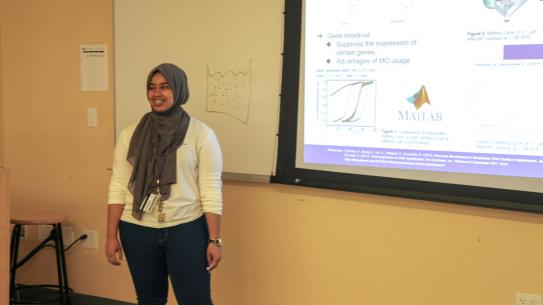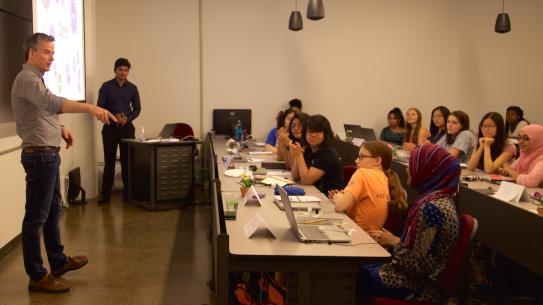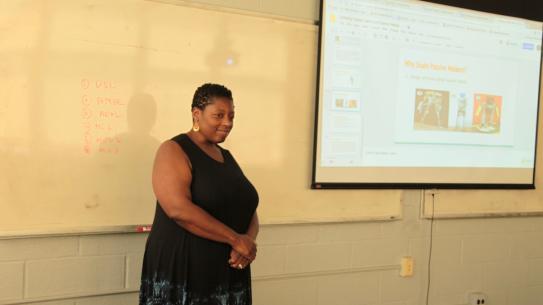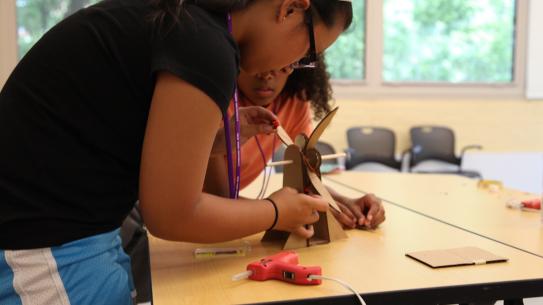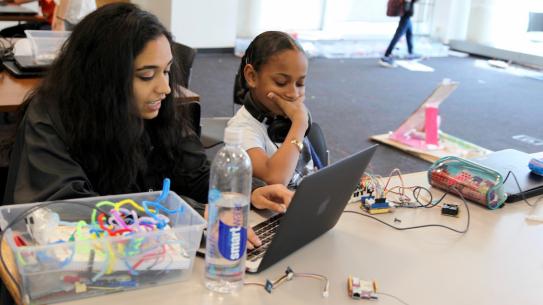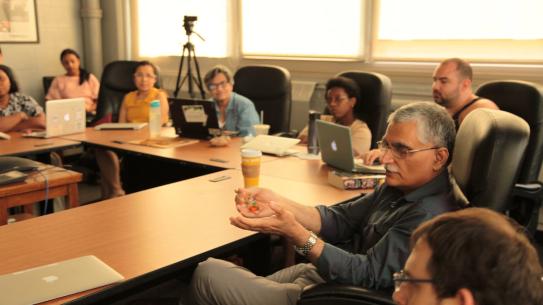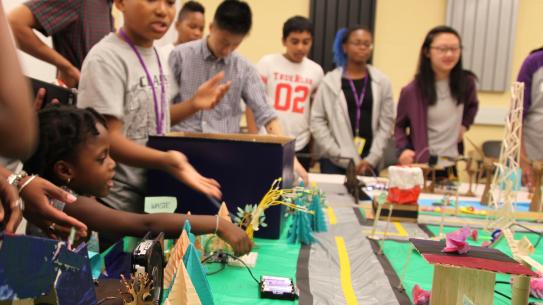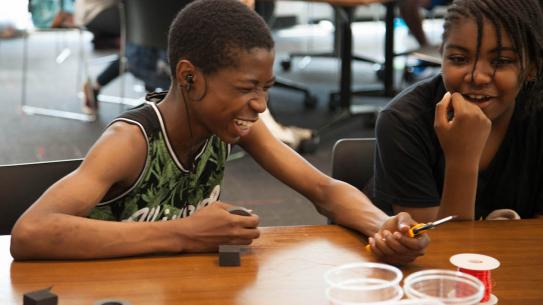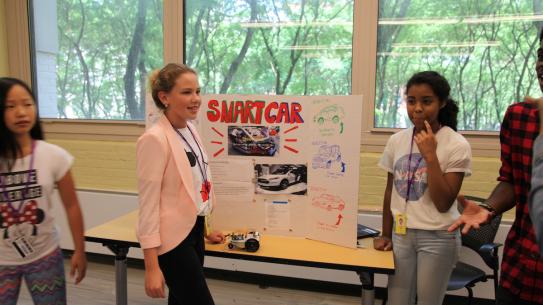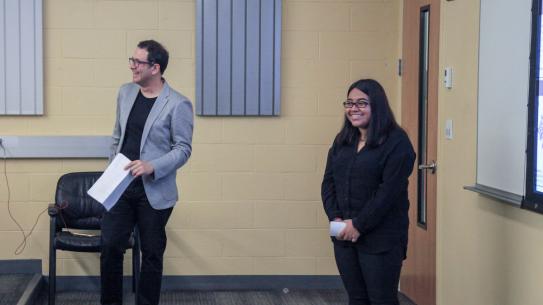Beyond Expectations: STEMNow’s New and Returning Programs Inspire Young Scientists and Engineers

A Science of Smart Cities participant shows off the features of a city she and her teammates created.
At a SONYC (Sounds of New York City) workshop for middle schoolers earlier this summer, students from the New York City-area learned how to make their own speakers. Using magnets and copper wire, they not only created portable devices to listen to the hits of the summer; they also learned how sound is electronically amplified and projected. Summer programming for K-12 students is offered annually at Tandon, and SONYC, besides being one of several National Science Foundation-funded programs, is also one of several new programs offered this year as part of the school’s STEMNow initiative. STEMNow offers summer programming intended to help elementary, middle, and high school students learn about cybersecurity, civil engineering, machine learning, and other topics in STEM that are relevant to both students’ interests and technological trends.
At another STEMNow program a few days before, Chris Nims, Security Chief at Oath, spoke to a class of high school girls about the importance of understanding technological vulnerabilities from a young age, and recent trends in hacking attempts. His visit was part of CS4CS (Computer Science for Cyber Security), a free three-week summer program providing an introduction on the fundamentals of cybersecurity and computer science while breaking down barriers and encouraging the cybersecurity professionals of the future to celebrate women and minorities in STEM. NYU Tandon Professor of Computer Science and Engineering Justin Cappos spoke to a cohort of CS4CS earlier in the summer about similar subjects, including his own childhood realizations about more analog security vulnerabilities.
“My friend and I were reading comics, and in the comic book there was an advertisement for a mail-order ant farm,” explained Cappos, grinning at the classroom of CS4CS students. “It was meant to be a fun science project. But I saw it as a way to send ants to anyone I knew.” The class laughs, and Cappos reminds them that this is how hackers see the world: they are constantly looking for vulnerabilities to exploit. In order to create safe virtual spaces, you have to understand all the ways that they can be exploited.
Also new this year was a three-week program called Artificial Intelligence for Autonomous Vehicles (AI 4 AV), developed in computer science and engineering professor and noted AI expert Anna Choromanska’s Machine Learning Lab. Here, students discovered one of the most popular deep-learning frameworks, called convolutional neural networks, and learned methods of collecting and manipulating data from the kinds of onboard sensors that autonomous vehicles will need to “see” the world around them. Then, to test their savvy, they implemented their own AI systems, and used these frameworks to “teach” a radio-controlled car to drive itself around an oval course.
iTEST, a returning National Science Foundation-funded program, and SPARC, a new program, are two explicitly robotics-focused courses. Both taught high school students how to construct and program robots that move and take orders. At the end of the 4-week iTEST program, participants were challenged to test their bots on a grid marked with a number of tables, and asked to deliver and bus coffee within the grid. “We said to this team, go to table 5, give them the coffee,” explained Professor Vikram Kapila, who leads NYU Tandon’s Mechatronics Controls and Robotics Laboratory, and who directed the challenge. “They took the coffee to table 5 and as they were coming back we told them go to table 3 and pick up the coffee. I had told all of them that we could ask many things, but they didn’t know ahead of time what table I was going to tell them. They didn’t know if I was going to ask them to drop coffee off or pick it up, any of that.” The winning team, from Brooklyn Tech, was able to complete all the tasks given to them with their rob.
ARISE, another returning program for high schoolers, concluded last week with students presenting the research they’ve done of individual projects. For Matzary Candia and Elaine Tanel, that research involved working with the NYU Center for Genomics & Systems Biology to better understand how chemical agents affecting the nervous system used in pesticides and nerve gas can be neutralized.
Tandon’s efforts to spark K-12 students’ interest in science and technology goes beyond daily programming for kids. STEMNow also provides workshops for teachers with RET (“Research Experiences for Teachers”) programs. RET provides teachers with access to experts, laboratories, lectures, demonstrations, and curricula that they can bring back to their classes during the school year. STEMNow organizers contacted professors and grad students prior to the teachers coming to give them a sense of how to structure the programs in a way that would make them most relevant and accessible to teachers, and to make sure the content they were learning was something they could take back to their classrooms. STEMNow also checks back in with teachers during the school year.
STEMNow program organizers are also mindful of the gender gap in technology, and have consciously worked to recruit female students and provide women-focused courses, including a brand new workshop for launching high school girls’ cybersecurity clubs, called Cyber Girls. As a result, about 60% of students enrolled in STEMNow programming this summer are female. “There’s a snowball effect in the school year that’s really significant,” says Ben Esner, Director of K-12 STEM education at Tandon. “Because of the Cybergirls program, for example, we’ve trained 6 teachers who are going to run computer science/cybersecurity clubs, with 20 girls in each club: that’s 120 kids.”
With seven National Science Foundation-funded courses and a handful of successful new programs, Esner mentions that next summer STEMNow may consider adding courses in new and increasingly important topics like augmented and virtual reality, machine learning, and blockchain.

Learn more about K-12 STEM Education
Annie Brinich
NYU Tandon School of Engineering
Master of Science in Integrated Digital Media, Class of 2019



